In Impoverished East UP, BJP Tries Star Power To Win Back Voters
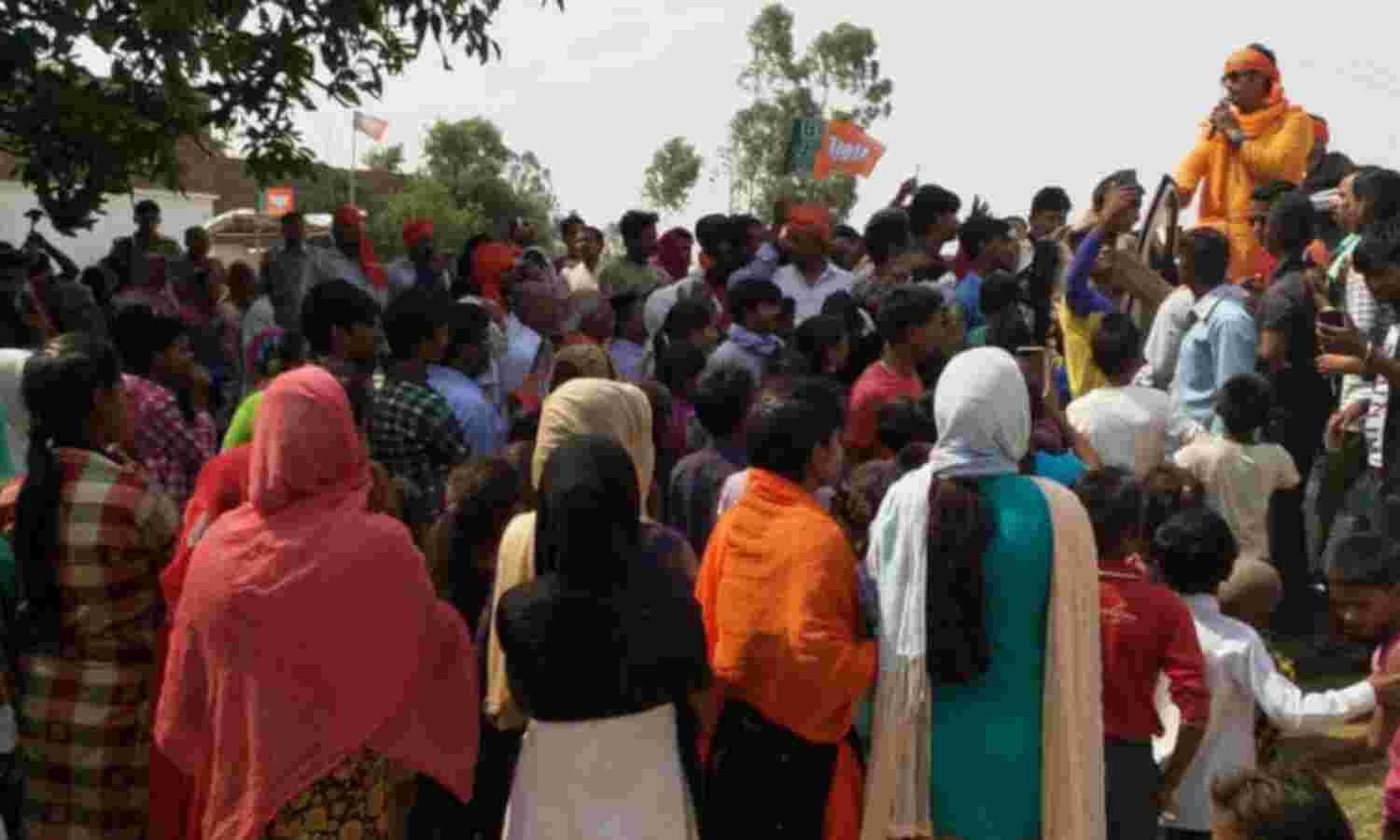
Gorakhpur and Sant Kabir Nagar (Uttar Pradesh): Ravi Kishan tied an orange safa (turban) around his head as his SUV stopped at a village named Domari No. 1. Kishan, the Bharatiya Janata Party (BJP) candidate from the city of Gorakhpur, is also called ‘Amitabh Bachchan of the East’, a superstar of Bhojpuri cinema in eastern Uttar Pradesh (UP) with 600 films to his name.
A woman from the village who saw his cavalcade stop could hardly believe her eyes--a star had actually stepped off the silver screen and stood right in front of her. She abandoned her egg stall, switched off the chulha (stove) and told her customers she was sorry she couldn’t serve them for now. She had to get a closer look at the movie-star.
Kishan’s candidature was unexpected and full of drama, just like his films. Here is his description of how he was offered the candidature: “I just got a call. The CM sir (chief minister of Uttar Pradesh, Yogi Adityanath) called me. He said ‘Are you ready to do service to society?’ I said, ‘Yes, I want to.’ He said, ‘You can.’ ”
Kishan’s story of his journey to Gorakhpur as a candidate was equally dramatic: “I have 11 films on the floor right now. I was shooting a Telugu film with Mr Bachchan and Chiranjeevi. And I got a call at 2 in the afternoon on April 14--that you have been finalised for Gorakhpur and you have to go. I didn’t go home. I called up my wife, called my children. I said, ‘Papa is going for service.’ They said, ‘What!’ I said, ‘Ya’. They love me so much so they said, 'Papa, sure. But win and come, don’t lose.’”
A year ago, the BJP had lost the Gorakhpur seat, an embarrassment for the party at multiple levels. First, it was a seat Yogi Adityanath had won five times in a row till he was made chief minister in 2017, leaving the seat free for re-election. Second, Gorakhpur is the city where Adityanath became a yogi, going from being Ajay Bisht to the mahant or head priest of the Gorakhnath peeth or temple trust. It has since been known as ‘the temple seat’.
Third, the seat was won in 2018 by someone from the opposition alliance--a young man called Pravin Nishad, the son of the founder of the NISHAD party formed only in 2016. It is a party whose name is an acronym but also the name of the founder’s caste, Nishad, one of the Other Backward Classes (OBC) in UP, and a broad grouping of various boatmen and fishermen communities.
The Nishads saw in the founder, Sanjay, an opportunity to be represented as a distinct political entity for the first time. The founder had written a book, Nishadon ka Itihas (the history of the Nishads), in which he redefined his community to include those who live across geography and time: The 15th century Italian explorer Christopher Columbus and the 16th century Portuguese explorer Vasco da Gama, for example.
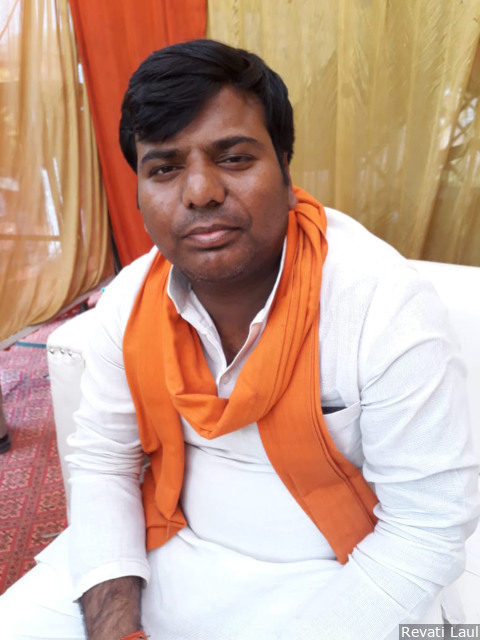
Pravin Nishad, who won the Gorakhpur Lok Sabha by-election--represented until then by current Uttar Pradesh Chief Minister Yogi Adityanath
In bending history, time and folklore, Sanjay Nishad pulled off a jugaad or a sleight of hand typical to UP. It is also how he got around India’s electoral rules that prohibit the formation of caste-based parties. Sanjay simply converted his caste name into an acronym that stands for Nirbal Indian Shoshit Hamara Aam Dal.
Sanjay Nishad’s son, Pravin, was a decade and a half younger than Adityanath. He was 29 and fresh out of an engineering school but managed to tie up with the BJP’s rival party, the Samajwadi Party (SP). He defeated the BJP in the 2018 bye-election by a narrow margin of 21,881 votes.
Pravin Nishad, however, switched loyalties in March 2019, opting to align N.I.S.H.A.D with the BJP’s National Democratic Alliance (NDA).
Was the electorate’s 2018 verdict against Adityanath or against the BJP in general? What did the reversal in Gorakhpur mean? It is now Ravi Kishan’s task to find the reasons and fix them.
The challenge of winning Gorakhpur
Ravi Kishan stepped out of his SUV and waved at his fans. A man from his cavalcade pulled out a rustic speaker and turned up the volume of a Bhojpuri song as Kishan threw his voice out loud with a homage to the gods: “Har har Mahaaaaaadev!” “Jai Shri Raaaaaam!”
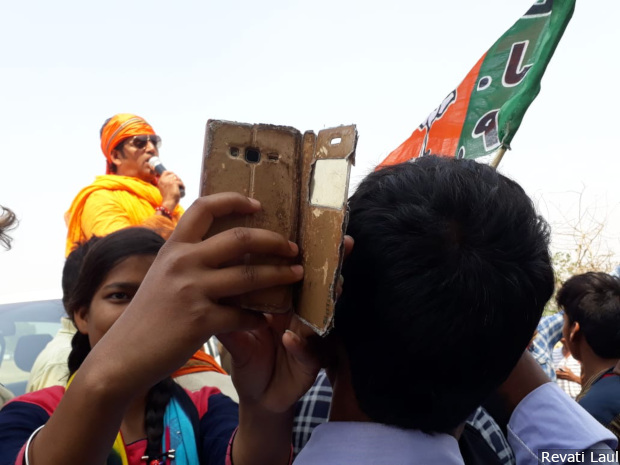
A young woman takes a selfie as Ravi Kishan, Bharatiya Janata Party candidate from Gorakhpur, addresses the crowd during his campaign. Kishan, also called ‘Amitabh Bachchan of the East’, has 600 films to his name and lost an election before--on a Congress ticket in 2014.
Kishan had lost an election before--on a Congress ticket in 2014. Bruised from that defeat, he admitted privately that it did not feel good to be cast aside after losing, so he switched parties. “After losing, not a single call I received from the Congress,” he said. “Just one call, like, ‘Hi, how are you, don’t worry, we are there.’ ”
Gorakhpur was one of India’s 250 most backward districts in a list drafted in 2007.
Just six months after Adityanath was sworn in as the chief minister, an incident had showed up the collapse of the state’s critical health infrastructure. In August 2017, at the state-run Baba Raghav Das (BRD) Medical College in Gorakhpur, 60 infants died because oxygen supply was stopped, allegedly because of unpaid bills.
Since then, the chief minister has had to battle voter perception that the state neglected basic healthcare. An AIIMS (All India Institute of Medical Sciences, which rank among the best government hospitals and research institutes in the country) was started in the city and its out-patient department has just about become operational. The BJP and Kishan have put this at the top of their list of the state’s achievements.
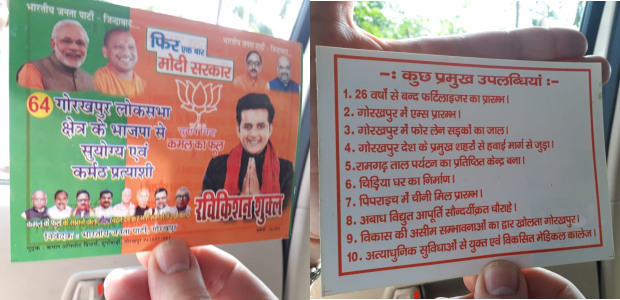
Cards listing achievements of the Bharatiya Janata Party government, particularly for Gorakhpur, are handed out at candidate Ravi Kishan’s meetings.
The state government also handed out statistics to the press claiming that infant deaths at the BRD Medical College showed a dramatic downturn the same month that the deaths occured: From an average of 18 deaths a day since 2014 it was actually down to less than one- third or 5.3 deaths a day by August 2017, the UP state health department claimed.
Electricity supply is another issue that is high on the BJP’s own list of achievements. The state government’s rural electrification programme, Saubhagya, claimed 100% coverage in the state. But in districts such as Gorakhpur, the area itself is on the power grid but individual households are not, as per a 2017 policy paper written for UP by the Council on Energy, Environment and Water, a think-tank. Most homes still use kerosene lamps, the study showed.
“For them the main barriers to adopting connections were the steep upfront cost, high recurring payments and unreliable supply of electricity,” the study said. Despite two-thirds of Gorakhpur being electrified, only 13% of the households are primary users.
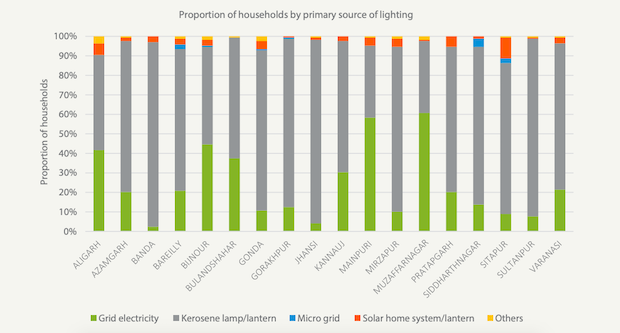
Source: Council on Energy, Environment and Water study, 2017
Employment, security, demonetisation--issues agitating voters
Less than a kilometre from where Ravi Kishan was campaigning in Domari No. 1, as soon as his cavalcade passed, people gathered around the local dhaba over pyaaz pakoras (onion pakoras) and a salty chutney for a political debate. Development, or the lack of, was the main theme.
Prabhakar Kumar, a young and fiery dalit, seemed the angriest of all. He voted for the BJP in the last general election in 2014 but would not this year.
“Mujhe to yeh lag raha hai ki BJP paanch saal me fail hai (I feel the BJP has totally failed in these last five years),” he said. As piping hot snacks were passed around, people such as Prabhakar flayed Modi for having famously said that making pakoras must be counted as a source of employment.
“Agar desh ke pradhan mantri padhey likhey log se pakoda bichwane kahey to isse zyada sharm ki baat ho hi nahi sakti (If the prime minister of the country is asking educated people to sell pakoras then what could be more embarrassing),” said Kumar.
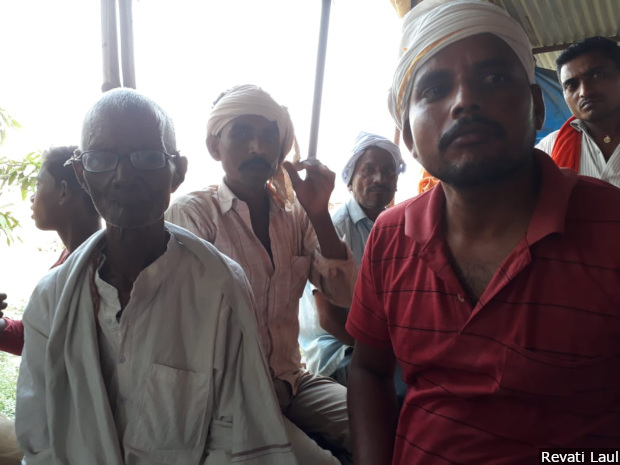
Prabhakar Kumar (right), a young and fiery dalit from Domari No. 1 village in Uttar Pradesh’s Gorakhpur, voted for the BJP in the last general election in 2014 but will not this year. “Mujhe to yeh lag raha hai ki BJP paanch saal me fail hai (I feel the BJP has totally failed in these last five years),” he says.
Chandrasekhar Paswan, a 42-year-old furniture maker, also from a Scheduled Caste (SC) like Kumar, spoke about unemployment in eastern UP and his perception that the government has done nothing about it. “Pakoda bechna hai to 27-28 saal padhane ki kya zarurat hai? (If they’re going to end up selling pakoras, why should we put our kids through 27-28 years of education?),” he asked. “Primary mein degree padhwa ke pakoda bichwa saktey hain (Primary school should have been enough).”
The conversation moved from pakoras to Pulwama where Central Reserve Police Force personnel were attacked by alleged Pakistani terrorists on February 14, 2019. The government had ordered retaliation through air strikes, and the Modi government and the BJP have been hard-selling this as the achievement of a “strong” government.
Ram Dulari Kannaujia, who retired recently as a laboratory assistant in the government health department, also from an SC, weighed in. “I read somewhere recently that a wise man challenged Modi to make an election speech for just two minutes without using the names of anyone from the Nehru family, Hindu religion or Hindu-ness, the building of the Ram temple at Ayodhya and the Pulwama attacks,” said Kannaujia. “He cannot do it.”
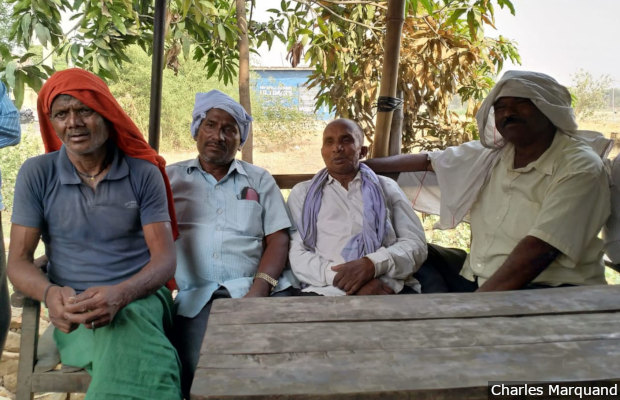
Residents of Domari No 1 village in Uttar Pradesh’s Gorakhpur discuss development, unemployment and security issues. While some believed the Bharatiya Janata Party (BJP) has “totally failed”, others are impressed by development and the focus on “securing our borders”.
At this point, Bakshish Ahmed Warsi, a 66-year old retired school teacher, out-shouted everyone in his loyalty to Modi and the BJP. “Modi aur Yogi ki sarkaar Hindustan ke andar agar hamara rashtra surakshit nahi hai, desh ki seemayein surakshit nahi hai, toh yeh mulk nahi surakshit hoga (If under Modi and Yogi’s government our borders are not secure then we are not safe),” he said. “Isiliye Modiji ne pehley Hindustan ki seemaon ko surakshit kiya hai (That’s why Modiji focused on securing our borders).”
Parshuram Sharma, an upper-caste farmer, was of the view that the BJP is a “syncretic party” that stands for inclusive development. “Hum bhajpa ko vote dete hain, hamarey vicharon mein pakshpaat aur jaat-paat ki ladai nahi hai--hamarey vicharon me vikaas ki ladai hai (I vote for the BJP and I don’t think that it is waging a battle of ideology or caste -- it is fighting for development).”
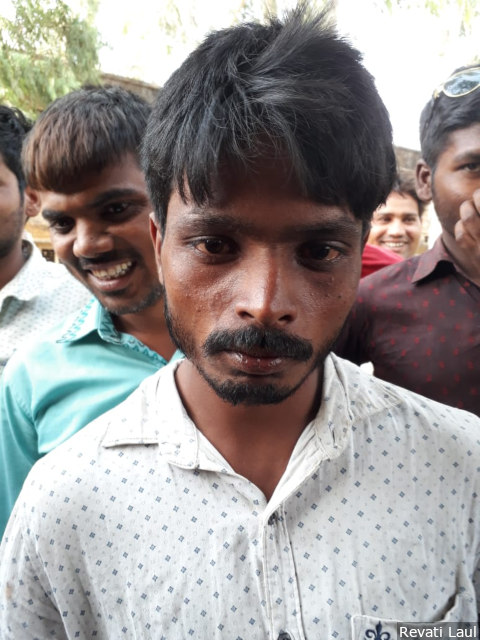
Parshuram Sharma, an upper-caste farmer from Domari No. 1 village in Uttar Pradesh’s Gorakhpur, says the BJP is a “syncretic party” that stands for inclusive development.
Kishori Lal, a farmer from the OBC group, brought up demonetisation, the invalidation of 86% of India’s currency (by value) in November 2016. “Notebandi se tamaam logon ko takleef hui thi (All people suffered because of demonetisation),” he said, adding that he was not a Modi fan.
What became apparent to us during the debate was that voters were not sticking to predictable positions. Some dalits who had voted the BJP last time were upset with the party this time around. Those from OBC groups, normally seen as BJP supporters, had turned critical of the party. And there was the odd Muslim BJP supporter. What was even more clear was that despite Gorakhpur’s economic backwardness and low literacy figures, the political discourse was peppered with examples from history, data and citations from the Constitution.
Rural Gorakhpur was angry and well-informed.
Brijen Prasad Nishad, an OBC, was upset with the new reservation policy Modi had proposed--10% for the economically deprived sections among the general category or forward castes. This would take away from the overall reservation quotas for backward and Scheduled Castes, he said.
The OBCs and SCs together make up more than 75% of UP’s population, so their support is crucial in any election.
Vijay Sahni, a farmer from an OBC caste, is upset with the BJP’s choice of candidate, Ravi Kishan. “Pichhli baar unko vote diya tha abh ki baar nahi diya jayega (I voted for the BJP last time but this time I won’t),” he said. “Pratyashi jo hain, yahan ke nahin hain. Isiliye sab log unko vote dene me sahmat nahi hain. Kalakaar aadmi hain, phir yahan par dikhai nahi denge (The candidate isn’t a local person. So people aren’t going to vote for him. He is an actor, we won’t ever see him here again.)”
At his meetings, Ravi Kishan did spend time tracing his roots to Gorakhpur--his family belonged to the district but migrated to Jaunpur and Varanasi. But perhaps Vijay Sahni had not heard him.
When rival turned ally
Pravin Nishad who wrested Gorakhpur from the BJP eventually joined the party in March 2019. But he is fighting from the neighbouring district of Sant Kabir Nagar, named after the 15th century Sufi and Bhakti poet.
His father, Sanjay Nishad, after fulminating against Modi and BJP president Amit Shah in earlier speeches, tied NISHAD to the NDA, as we mentioned earlier.
“People from my community are dying of hunger and the prime minister is busy touring abroad,” he had said in a speech delivered in July 2016 in Gorakhpur.
But why was not Pravin Nishad contesting from Gorakhpur which had voted him to power in 2014? No one in the BJP had a satisfactory answer but it set off a wide set of guesses. One was that there was infighting in the BJP and an attractive and popular outsider like Kishan could dissolve the tension. Another was that Adityanath did not want a powerful contender to a seat he saw as his home turf.
Pravin Nishad’s own response was this: “Ek nau jawaan ki zarurat kahin bhi mehsoos hoti hai to aap nisankoch, is bharat ko shaktishaali bananey ke liye hamara upyog kar saktey hain. If the need for a young candidate is felt anywhere, you (the BJP) can deploy me without hesitation to strengthen India,” he said.
At a stage erected in a large maidan in Khalilabad, the district headquarters of Sant Kabir Nagar, Pravin Nishad sat backstage waiting for the guest of honour to kick off his campaign–Amit Shah. Nishad sat on one sofa while another, covered with white towels, was reserved for Shah, no one else was permitted to sit on it--a special seat reserved for a guest by a party that is fighting upper-caste privilege.
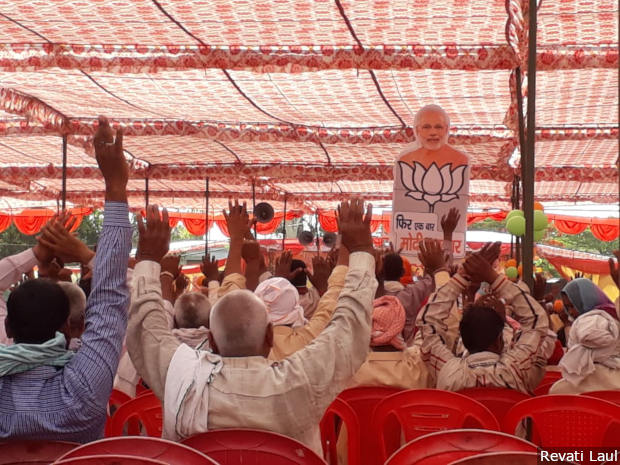
Supporters of the Bharatiya Janata Party attend a campaign rally in Khalilabad, the headquarters of Sant Kabir Nagar district. Large speakers on the stage play popular qawwalis and songs remixed with BJP propaganda.
Large speakers on the stage played popular qawwalis and songs remixed with BJP propaganda. Music with an Islamic influence to entice an audience to Shah’s religiously polarised speech that followed. “Pakistani aatankvaad ke ghar me ghus-ghus ke maarenge (We will kill Pakistani terrorists in their homes),” Shah said. He added the customary jibes at opposition parties--the SP and the Congress, he alleged, will burst crackers with the Pakistanis. The final piece was about “infiltrators” in India who would be singled out and weeded out one by one (chun-chun ke). People in the party de-coded this to mean Muslim “infiltrators”.
“Hindu ghuspaith kaise ho saktey hain (How can Hindus possibly be infiltrators)?” asked a young BJP party worker in Gorakhpur.
‘We will support those who support us’
A young upper-caste participant at the rally, Angad Tiwari, looked uncomfortable with the profile of those around him. Amit Shah was canvassing for Pravin Nishad. And that, for Tiwari, was turning out to be a problem because it changed the caste profile of the party.
“I am a Brahmin and no one from my community is here,” said Tiwari. A group of young boys sitting at the back in red plastic chairs said they were actually SP supporters and were at the BJP rally for “time-pass”. Many were from the Nishad caste and were also at the rally for that reason.
Pravin Nishad’s supporters were confused with all the mixed-messaging but the young leader had his defence ready. “Dekhiye, ek naara diya hai hum logon ne (Look, we’ve coined a slogan for our party),” he said as a man in a grey safari suit with an automatic weapon waited in the wings. “Jo hamari hisseydaari dega, hum uske bhaagidaari denge. (Whoever gives us their support, gets our support).”
Gorakhpur and Sant Kabir Nagar are full of towns where shanties stick to one another, grey and dirty, with no drainage and often, no windows. And in their midst, shiny new malls rise, as if asking new aspirants to the middle class to claim their space or fight for it.
In Gorakhpur, right opposite the massive and sparkling white Gorakhnath temple with recreational boating for families, was a street that had nothing shiny about it. At a mango-seller’s cart, 55-year old Fayaz Siddiqui and another street-side vendor, Ramesh Sonkar, were arguing about what development meant to them. They were interrupted by a destitute woman in rags, named Gujarati.
“I have no husband, no home and no voting ID,” she said. “I tried to get one but I haven’t succeeded yet,” she added, imploring IndiaSpend to see how she lived, just one street away from the temple that brought fame to the chief minister as a holy man who gave food and alms to the poor.
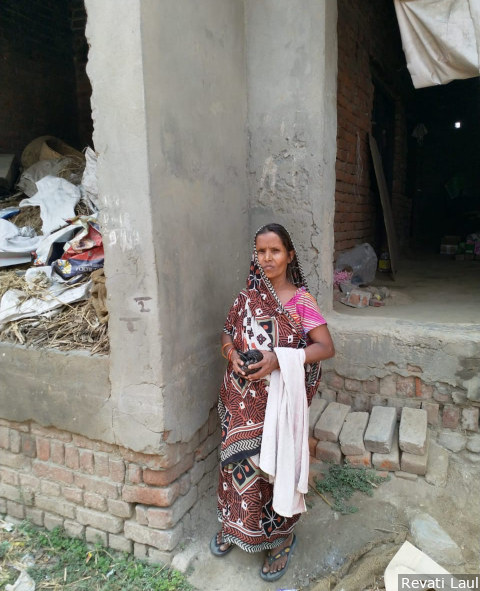
Gujarati, a destitute woman, lives on the street right opposite the massive and sparkling white Gorakhnath temple--farthest possible from any sort of campaign. Or development.
Gujarati pointed to a large rubbish dump at the end of the road, propped up against a wall. There was no home there, no door, nothing. Just a section of broken wall against which she propped a bundle of clothes and a cot. She was the farthest possible from any sort of campaign. Or development.
In another corner of the city, Ravi Kishan repeated his refrain--that the Gorakhnath temple was “taking care of the people,” and Gorakhpur, devolving from that largesse, is a “BJP gadh” or stronghold. It was until a year ago.
(Revati Laul is an independent journalist and film-maker and the author of 'The Anatomy of Hate,’ published by Westland/Context in December 2018.)
We welcome feedback. Please write to respond@indiaspend.org. We reserve the right to edit responses for language and grammar.


